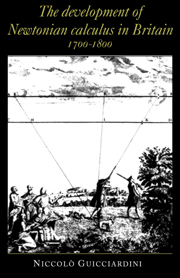Book contents
- Frontmatter
- Contents
- Introduction
- OVERTURE: NEWTON'S PUBLISHED WORK ON THE CALCULUS OF FLUXIONS
- PART I THE EARLY PERIOD
- PART II THE MIDDLE PERIOD
- PART III THE REFORM
- CONCLUSION
- APPENDIX A TABLES OF CONTENTS OF FLUXIONARY TEXTBOOKS
- APPENDIX B PRICE LIST OF MATHEMATICAL BOOKS PRINTED FOR JOHN NOURSE
- APPENDIX C CHAIRS IN THE UNIVERSITIES
- APPENDIX D MILITARY ACADEMIES
- APPENDIX E SUBJECT INDEX OF PRIMARY LITERATURE
- APPENDIX F MANUSCRIPT SOURCES
- Notes
- Bibliography
- Index
OVERTURE: NEWTON'S PUBLISHED WORK ON THE CALCULUS OF FLUXIONS
Published online by Cambridge University Press: 14 September 2009
- Frontmatter
- Contents
- Introduction
- OVERTURE: NEWTON'S PUBLISHED WORK ON THE CALCULUS OF FLUXIONS
- PART I THE EARLY PERIOD
- PART II THE MIDDLE PERIOD
- PART III THE REFORM
- CONCLUSION
- APPENDIX A TABLES OF CONTENTS OF FLUXIONARY TEXTBOOKS
- APPENDIX B PRICE LIST OF MATHEMATICAL BOOKS PRINTED FOR JOHN NOURSE
- APPENDIX C CHAIRS IN THE UNIVERSITIES
- APPENDIX D MILITARY ACADEMIES
- APPENDIX E SUBJECT INDEX OF PRIMARY LITERATURE
- APPENDIX F MANUSCRIPT SOURCES
- Notes
- Bibliography
- Index
Summary
when at the beginning of the eighteenth century the Newton–Leibniz controversy exploded, the great majority of British scientists declared their loyalty to Isaac Newton. In their opinion the calculus of fluxions had been invented long before the differential calculus of Leibniz and had been stolen by the German philosopher. It was also generally maintained that Newton's calculus was more firmly grounded than Leibniz's: not only was it thought that Newton had been the first to invent the calculus, but also that he had laid its scientific foundation. It was not clear, however, which was the genuine form of the calculus of fluxions since it was difficult to derive a coherent idea of it from Newton's work.
Newton's first published work on fluxions, ‘De quadratura’ (1704c), appeared in 1704 as an appendix to Opticks (1704a). This was followed in 1711 by the ‘De analysi’ (1711b), a tract written in c. 1668/9. And then, of course, there were the Principia (1687) with their huge apparatus of mathematical techniques. It was not until 1736 that there appeared in English, with the title The Method of Fluxions and Infinite Series, the translation of a long and comprehensive treatise which Newton had composed in 1671. All the Newtonians agreed that the calculus of fluxions was contained in these works. However, in the Principia there was no proper algorithm of fluxions, even though series and some algebraical manipulations with ‘moments’ occurred, especially in the second book.
- Type
- Chapter
- Information
- Publisher: Cambridge University PressPrint publication year: 1989



